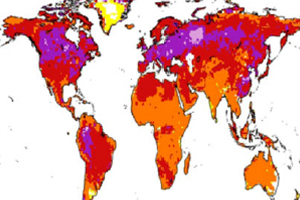LBNL and NCAR did a joint press release on a recent paper about heat waves. The PR went fairly viral with over 800 reposts as best I can tell. Some with interesting comments… (My favorite being that Diana Ross told us all about heat waves in the 1960s. MFW.)
Click this link for the original LBNL press release:
http://cs.lbl.gov/news-media/news/2016/new-study-details-the-searing-future-of-extreme-heat/
Here is an alternative summary:
In a recent paper in the journal Climatic Change, DOE BER RGCM funded researchers Claudia Tebaldi (NCAR) and Michael Wehner (LBNL) analyzed the effects of significant reductions in future greenhouse gas emissions on short-term extreme hot and cold events. Tebaldi and Wehner applied Generalized Extreme Value (GEV) analysis techniques to the output from the large ensemble projections of the Community Earth System Model to estimate 20-year return values of daily and 3 day average maximum and minimum temperatures over the course of this century under future high (RCP8.5) and low (RCP4.5) emissions scenarios. They found that about 95% of land regions would see reductions of 1°C or more in these measures of very extreme temperatures by reducing the future increase in global mean temperature from 3.3 to 1.9oC, and 50% or more of the land areas would benefit by at least 2°C. 6% of the land area would benefit by 3°C or more in projected extreme minimum temperatures and 13% would benefit by this amount for extreme maximum temperature. The future frequency of current extremes is also greatly reduced by mitigation: by the end of the century, under the high emissions pathway more than half the land area experiences the current 20-year events every year while only between about 10 and 25% of the area is affected by such severe changes in the reduced emission scenario.
This work is joint between two larger efforts, Benefits of Reduced Anthropogenic Climate change at NCAR, which explore a wide range of such benefits and Calibrated and Systematic Characterization, Attribution and Detection of Extremes at LBNL, which is focused on extreme weather in a changing climate. See https://chsp.ucar.edu/brace-benefits-reduced-anthropogenic-climate-change and other papers being published in the same special issue of Climatic Change.
Citation: Claudia Tebaldi and Michael Wehner (2016) Benefits of mitigation for future heat extremes under RCP4.5 compared to RCP8.5. Early online release Climatic Change. DOI:10.1007/s10584-016-1605-5

The difference in 20 year return values of annual maximum daily maximum temperature at the end of this century between a no policy scenario (RCP8.5) and a significant mitigation scenario (RCP4.5).

